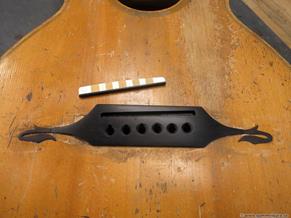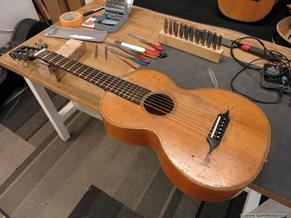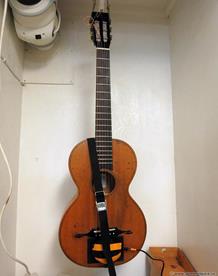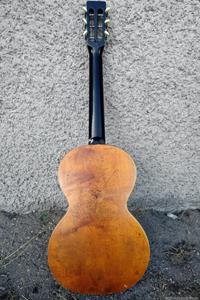The work has continued in my room despite the heat and high humidity. My dehumidifier broke and for a few days I had 68% in the room! You can not glue ribs or the bottom in that moisture. Luckily I had to borrow a dehumidifier from Per Marklund and a new one is on the way. In any case, the fan has not broken…
A nice and small European parlor is ready, the men's watch is 60 cm. The men's watch is usually 60-63 cm for European parlor and the most common size is 62 cm. Levin parlors also have a mens watch of 62,6 cm (probably an inch) before about 1930, later vintages regardless of model almost always 63 cm.
This one didn't have bar frets, but the neck attachment was of Spanish type and the grip board in two parts. I have seen several guitars with the same design and probably the same manufacturer. They are older than most old guitars that appeared and made around 1890. Would be interesting to know where and when they were manufactured. This one did not have inlays in pearls in the form of flowers on the loose part of the grip board on top of the lid that they had previously had. The ends of the stable had glued decorations that were common on really old guitars. They were gone but there was an imprint in the paint that I used to make replicas.
The Spanish neck attachment makes it impossible to replace the neck, which was needed. The solution was to make a new neck block and cut the end of the neck into a matching dove tail. A little tricky but it went well in the end. The tuning screws were working, but the customer wants them replaced with new ones. Fingerboard and stable in black-painted maple were replaced with replicas in ebony. A carbon fiber rod in the neck and a K&K mic were mounted. With a saw, I made the two decorations in the stable. Looks good I think.
Had some trouble finding the right angle on the neck and the right distance to the stall leg on the stable. Got glued around the neck an extra time which is never fun. Since the guitar was made for late strings, the neck foot needed to be angled up a lot and about 3 mm was removed on the already thin conical neck foot. Inserted a shim of 3 mm to make the neck foot stronger and to hit right with the tone. Both the height of the stable leg and the intonation became very good in the end, but it was not easy.
A translucent plectrum cover was glued to the lid, you can easily loosen it by heating with a hair dryer and gently pull it off if you wish. It got the usual extra in the form of plugs, segmented stall legs and oversaddle linting.
Some pictures from different stages of the work.
Just bought a new camera and the memory card came loose unexpectedly without me knowing it while I was taking the last pictures before the guitar was sent off. The pictures are from both the new and the old camera. The liquor-coated maple in the bottom and side as well as the lid has a lovely patina!
The guitar sounds good with an unusually soft and warm tone. Liked this sharply!



















